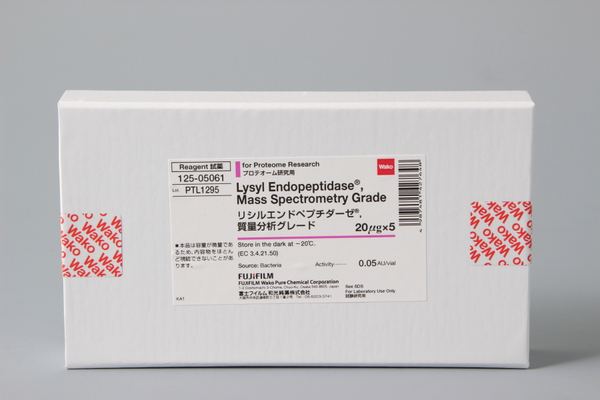Lysyl Endopeptidase, MS Grade
Product Code: #125-05061
Packaging: 20ug×5
Base price 4000 元
Sales price 4000 元
Discount
Price / kg:
Description
This product is for research use only. Do not administer it to human.
[BIOCHEMISTRY]
For Proteome Research!
Among the most important techniques in proteome analyses is the in-gel digestion of protein spots/bands that have been resolved by electrophoresis using digestive enzymes, such as trypsin and lysyl endopoptidase. Proteins can be identified by mass spectrometry analysis of the peptides produced by in-gel digestion, and further information regarding post-translational modifications can be obtained.Lysyl Endopeptidase, Mass Spectrometry Grade is a freeze dried product that retained sufficient activity for in-gel digestion and packed in very small quantities for convenience purposes.
[Features]
- High specificity and efficiency of protein digestion allow for easy database searches by peptide mass.
- Improved cleavage at lysine residue and increase in the number of peptides are obtained by combination with trypsin.
- Packed in very small quantities according to the amounts used so that sufficient activity for in-gel digestion may be retained.
- Wako Catalog #293-57701 Negative Gel Stain MS Kit, for Electrophoresis (20 tests)
- Wako Catalog #299-58901 Silver Gel Stain MS Kit, for Electrophoresis (20 tests)
[Physical properties]
- Appearance: Lyophilized form containing ca. 10% Tris-HCl buffer, pH 8.
- Activity: Shown on each label
- Molecular Weight: 27,000 (gel filtration); 30,000 (SDS electrophoresis)
- Solubility: Soluble in water or buffer solution.
- Stability: Stable at 4 degrees C, when dissolved in buffer of pH 5~12. Stable at 30 degrees C in the range of pH 6~11, but unstable at 50 degrees C or higher.
- Optimal pH: 9.0 -9.5 (Amidase activity)
- Isoelectric point: 6.9~7.0
- Substrate specificity:
Hydrolysable substrate ... Tos-Lys-Ome, Bz-Lys-NH2, Bz-Lys-pNA, Lys-pNA
Unhydrolysable substrate ... Bz-Arg-NH2, Bz-Arg-pNa, Arg-pNA
- Inhibitors: DFP, PMSF, TLCK
[References]
- Wada, Y., and Kadoya, M.: J. Mass Spectrom., 38, 117 (2003).
- Shevchenko, A., Wilm, MM., Vorm, O., and Mann., M.: Anal. Chem., 68, 850 (1996).
Source: Bacteria
Originally, the source of this product was indicated as "Achromobacter lyticus" based on the physiological and morphological properties of the bacteria. However, we confirmed that the 16SrDNA sequence was highly homologous to that of Lysobacter
Reviews
There are yet no reviews for this product.
